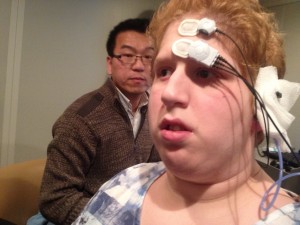Hear’s to the Team!
The body is a noisy place. Hearts beat, blood swooshes, eyes blink. Even patient movement can interfere with sensitive audiometry testing devices used to determine if a person can hear.
This was the challenge faced by VGH audiologists recently as they tried to determine the extent to which 29-year-old Dana Mitchell’s hearing had been affected by years of chronic ear infections and the complications of treatment.
As a patient with autism spectrum disorder and the developmental disabilities, Dana’s ability to understand the need for testing was limited. Her fear of hospitals made the task of testing that much more difficult as well.

Dana Mitchell, 29, successfully underwent a full hearing test with VGH Audiology Practice Lead, Dr. Qi Li, on March 5. She was the first patient to take advantage of the new technology that is now available at the hospital, thanks to funding from the VCH Innovation Fund.
“Dana was a challenging patient because of her short attention span, constant movement and non-consistent responses,” said Qi Li, Audiology Practice Lead, VGH Neuro-Otology Unit. “We tried several traditional tests but it was impossible to obtain accurate, reliable, ear-specific and frequency-specific hearing results from Dana.”
After several meetings with Dana’s family, her health care providers, her referring physician and researchers at the UBC Audiology program, the VGH audiology team concluded the best way to test Dana’s hearing would be via the use of a new piece of technology from Vivosonic, the Integrity 500.
The Integrity 500 uses advanced in-situ amplification and wireless technology to take readings directly from the auditory system, significantly reducing interference from the body’s own artifacts or other ambient noises.
Because of the unique needs of many patients, such as Dana, the VGH audiology team applied to the VCH Innovation Fund to purchase the technology required.
It is the first system of its kind to be installed at a hospital in Western Canada. The Integrity 500 was installed at March’s start and Dana was the first patient to use it on March 5.
The new test confirmed that Dana had some hearing in her right ear. This means that Dana, with the help of some clinical interventions, will again be able to hear music; the single greatest joy in her life.
“To have Dana live in a silent world without music would be inhumane,” said Shelley Mitchell, Dana’s mom. “That Dr. Li and his team found a way to test Dana to determine if she could hear is as important as if they’d given her a new heart.”
For VGH audiologists, having access to this testing technology means they can now obtain accurate readings from patients who are very young, very old or suffer from cognitive disabilities, like Dana.
It’s also resulted in speedier testing times, allowing the units four audiologists to reclaim as much as an hour of time each per day.
“This success story amplifies how our team works together, striving toward True North, to find solutions to patient and work-place challenges,” said Qi. “Many people played important roles in this instance, including Dana’s family who provided unwavering trust and support, Dr. Susan Small from UBC audiology program and Dr. Desmond Nunez, Dana’s referring physician.”
Thanks to everyone’s critical inputs and suggestions, the solution found to address the testing challenges posed by Dana will benefit other audiology patients at VGH well into the future.
